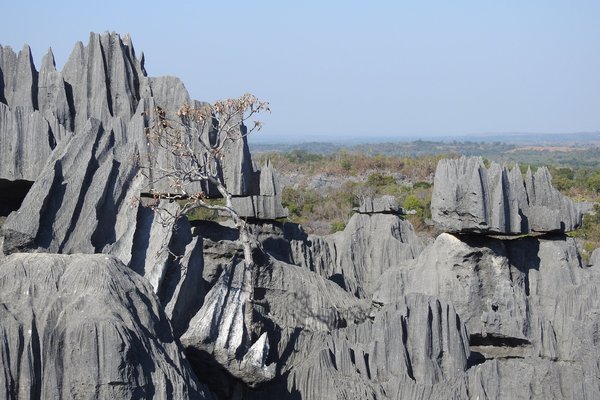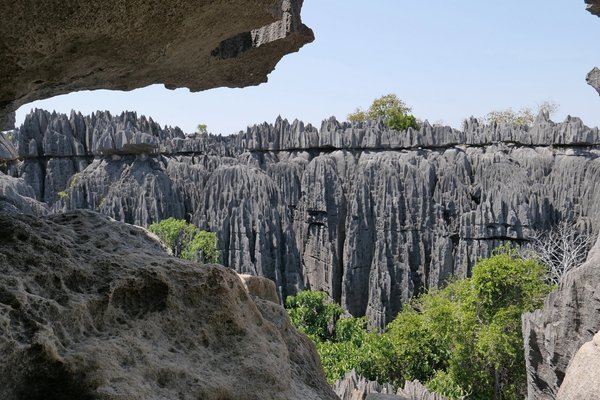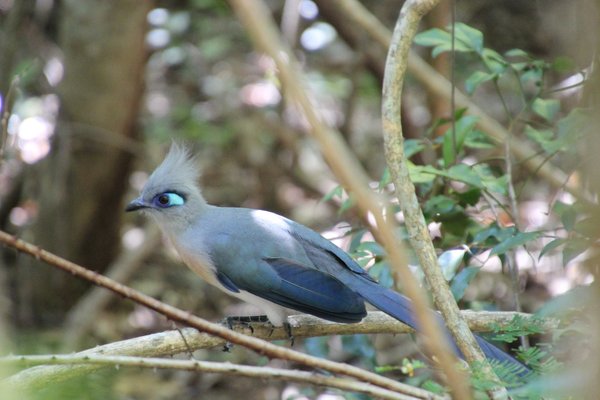Madagascar
Andrefana Dry Forests
The Andrefana Dry Forests represent centres of endemism within its western dry forests and southwestern dry thorny forests.
The habitat in the four national parks and two special reserves evolved in isolation. The dry forests are known for their baobabs and many endemic species of fauna. In addition, Tsingy de Bemaraha Strict Nature Reserve covers a spectacular landscape of limestone karst pinnacles.
Community Perspective: this is a hard site to reach, "an adventure, and not for everybody". Practical details on how to get to Tsingy de Bemaraha, for example, can be found in the review by Els. Randi & Svein did the 6-7 hour-long Grand Tour at Grand Tsingy and reported that in 2024, there is no armed escort necessary anymore to reach the site.
Site Info
Official Information
- Full Name
- Andrefana Dry Forests (ID: 494)
- Country
- Madagascar
- Status
-
Inscribed 1990
Site history
History of Andrefana Dry Forests
- 2023: Name change
- From Tsingy de Bemaraha to "Andrefana Dry Forests" upon extension.
- 2023: Extended
- To add (to the original Tsingy de Bemaraha) five protected areas, including the National Parks of Ankarafantsika, Mikea and Tsimanampesotse, and the Special Reserves of Analamerana and Ankarana.
- 2023: Criteria
- Criterion IX added upon extension
- 2008: Revision
- Includes former TWHS Ankarafantsika (1985) and parts of the Sud Malagache (Tsimanmpesotse) former TWHS (1985)
- 1990: Inscribed
- Inscribed
- 1990: Revision
- Includes former TWHS Gorges de Manabolo (1985)
- 1988: Deferred
- Nomination to be re-worked
- Type
- Natural
- Criteria
- vii
- ix
- x
Links
- UNESCO
- whc.unesco.org
- Official
-
- parcs-madagascar.com — Réserve naturelle du Tsingy de Bemaraha
All Links
UNESCO.org
- whc.unesco.org — whc.unesco.org/
Official Website
- parcs-madagascar.com — Réserve naturelle du Tsingy de Bemaraha
Community Information
- Community Category
- Natural landscape: Forest
Travel Information
Not for Acrophobes
Guided Tour Only
Recent Connections
-
Not for Acrophobes
Grand Tsingy of Tsingy de Bemaraha ("ro… -
Guided Tour Only
To visit either Petit or Grand Tsingy, … -
Best seen from the sky
Connections of Andrefana Dry Forests
- Geography
-
-
Canyons
the spectacular canyon of the Manambolo river - Unesco website
-
- Trivia
-
-
On Banknotes
On the 500 Ariary note -
In Video Games
Civilization VI
-
- Ecology
-
-
Strepsirrhini
Various lemurs -
Turtles and tortoises
Madagascar big-headed turtle (IUCN Outlook 2020) -
Mangroves
"mangrove swamps" -
Significant Karst Features
Extensive areas of very sharp limestone pinnacle karst (AB ev) -
Hoodoo
"The 250 km long Bemaraha Plateau, composed of mid-Jurassic (approximately 200 mya) limestone of marine origin (Du Puy and Moat 1996), is heavily eroded into a karst landscape characterized by networks of deep crevasses, underground rivers and caves, separated by spectacular pinnacles of limestone, up to 100 m high, forming a “forest of sharp stones”" (IUCN outlook 2020) -
Endemic Bird Species
West Malagasy dry forests EBA, Bemaraha Tsingy National Park IBA: Coquerel's Coua, Schlegel's AsitySee www.birdlife.org
-
Critically endangered fauna species
Madagascar fish-eagle (ca. 240 remaining), Madagascan big-headed turtle -
Strict Nature Reserve
Partly: Tsingy de Bemaraha Strict Nature Reserve, "access to the Strict Nature Reserve is currently limited except for scientific purposes and guided tours" (UNEP-WCMC) -
Tropical and subtropical dry forests
"covered by a dense, dry and deciduous forest" (OUV) -
Refugium
"The centres of endemism on the western slopes were refugia that captured parts of the hydrological system, allowing animal and plant populations to survive in isolation during dry periods." (Crit IX)
-
- Damaged
-
-
Threatened by Oil and Gas Exploration
Potential: "There are natural gas deposits under the property, but the concession holder Madagascar Oil is staying away from the site, respecting the 2.5 km protective zone." (IUCN Outlook 2020)
-
- World Heritage Process
-
-
Extended
From Tsingy de Bemaraha (2023), + 5 locations. -
First inscriptions
Madagascar 1990
-
- Human Activity
-
-
Petroglyphs
A number of ancient cemeteries occur on the plateau and in a cave in the Manambolo Gorge which has petroglyphs doubtfully attributed to the proto-Malagasy Vazimba people (UNEP-WCMC)
-
- Constructions
-
-
Notable Bridges
Suspension bridge
-
- WHS on Other Lists
-
-
World Heritage Forest Programme
-
Centres of Plant Diversity
IO1 Madagascar - "Madagascar’s different forest types are home to 80% of its endemic species, and the dry forests make a major contribution to this richness. … the component parts added in 2023 include almost one thousand endemic species and sub-species of plants" -
WWF Global 200
Terrestrial, Tropical and Subtropical Dry Broadleaf Forests: (51) Madagascar Dry Forests; and Terrestrial, Deserts and Xeric Shrublands: (125) Madagascar Spiny ThicketSee web.archive.org
-
Alliance for Zero Extinction
Avahi cleesei (Bemaraha Woolly Lemur), Boophis tampoka -
Biodiversity hotspot
Madagascar and the Indian Ocean Islands -
IUGS Geological Heritage Sites
Tsingy of Bemaraha -
Ramsar Wetlands
Zones humides d’Ambondrobe +Complexe des lacs de Manambolomaty
-
- Timeline
-
-
Jurassic
Les formations des Tsingy remontent à la séparation de l'Île de Madagascar de la plaque africaine, il y a 160 millions d'années. (Wiki)
-
- Visiting conditions
-
-
Best seen from the sky
-
Not for Acrophobes
Grand Tsingy of Tsingy de Bemaraha ("rock, ladders, chasms, stone steps, steel cables, and the constant fear of falling and getting injured") -
Guided Tour Only
To visit either Petit or Grand Tsingy, you must be accompanied by an accredited local guide from the park office.
-
News
No news.
Recent Visitors
Visitors of Andrefana Dry Forests
- AC
- alex
- Alexander Lehmann
- Atila Ege
- Bram de Bruin
- Dennis Nicklaus
- Els Slots
- Fan Yibo
- Iain Jackson
- Janos
- jballard650
- Jonoprout
- Justin Rickey
- Kevin McFarland
- Knut
- Lucio
- marcel staron
- Michael Ayers
- Mihai Dascalu
- Mikan22
- Morodhi
- Nihal Ege
- Olli-Pekka Turunen
- PabloNorte
- Paul Schofield
- Philipp Leu
- Randi Thomsen
- Rosemary
- Svein Elias
- Wojciech Fedoruk
Community Reviews
Show full reviews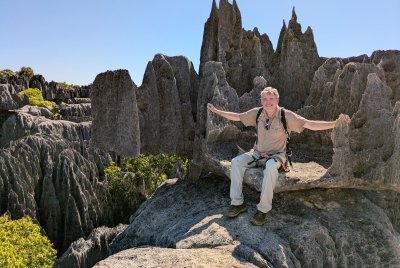
I was really pleased to visit the Tsingy de Bemaraha, because an article years ago in National Geographic about them was what really got me interested in visiting Madagascar. Climbing on, and walking through the tsingy was really fun. You're really exploring an odd landscape.
Getting There
We visited in mid-May, near the beginning of the season there, as the roads aren't reliably dry enough to be open before May. Our trip was similar to what others have mentioned here; the trip getting to the tsingy is really a large part of the experience. We flew to Morondava, then briefly enjoyed the Avenue of the Baobabs en route to a one night stopover in the Kirindy Forest. Here we stayed in pretty rustic cabins (no hot water, limited hours electricity) at the Akiba Lodge, but loved the place -- the lemurs are just steps from your cabin. The next day, it's back in the car for the drive to Bekopaka, the village near the tsingy. About halfway there, we stopped for lunch at what we considered Madagascar's best restaurant, the Mad Zebu in Belo Tsiribihina.
After lunch, it's a long ferry crossing, then the drive gets interesting. As in, probably the worst road in the world that I have experienced. Deep ruts, deep mud, multiple stream crossings. At one point, a car a couple cars in front of us got deeply stuck in the mud. The road is narrow, so that if a car gets stuck, …
Keep reading 0 comments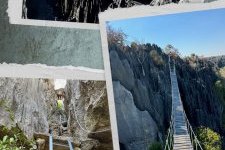
Els has covered this site pretty good, but we like to add a few comments.
First of all, what an adventure to get here! We really enjoyed the drive through wonderful lansdscape, small villages and the river crossings. We stayed three nights, two days and did the Grand Tsingy first. For the Grand Tsingy, our guide convinced us to do the Grand tour, combining circuit Ranotsara, Broadway and Andamozavaky. It will take about 6-7 hours and almost no one does it. And he was right, we didn’t meet any other people until at the end. The route adds one more viewpoint and a hanging bridge. And as Els explained, we used harness to clip on to safety ropes, up ladders and stepping stones, climbing our way to the top. I am impressed how they made this marvelous rocky terrain available to «common people». The view from the top is just fantastic. Besides the climbing the track is winding through caves,(several places we have to squeeze ourselves through), boulders, rocky terrains and sometimes easy hiking in the forest. We encountered four kinds of lemurs: the Deackens Sifaka, several groups of Red faced Brown Lemurs, Bamboo Lemur and the Red-tailed Sportive Lemur (nocturnal, sleeping on a tree in the afternoon sun). We used in total 7 hours, with plenty of photo stops and a lunch break.
Day two we did the River Gorge and the Small Tsingy. It was well worth to stay an extra day
When you are …
Keep reading 0 comments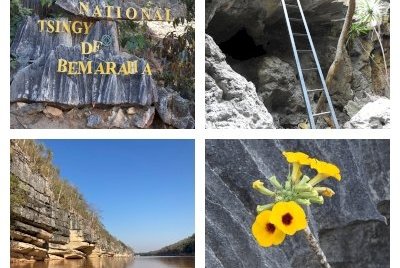
Although it has decent tourist facilities, the Tsingy de Bemaraha is only for the hardened traveller as realistically there is no easy way to reach this park on the west coast of Madagascar. The property is so poorly accessible from the nearest city or commercial airport that it almost fits into our ‘Takes more than 5 days’-connection: a return trip takes at least 5 days from Tana. To make matters worse, it nowadays should be visited as part of an armed convoy due to safety concerns as there have been robberies along the route. There is no public transport to the site, all has to be done by 4WD, although the very wealthy could charter a bush plane and land on an airstrip that lies some 8km from Grand Tsingy.
The road to Tsingy from the coastal city of Morondava (195km/8h) starts with a passage through the well-known Avenue of the Baobabs. From that point on, the sand road is all there is – Tsingy for that reason also is inaccessible during the rainy season. A bit further on lies the turn-off for Kirindy Forest, a park that has severely deteriorated since Covid: people abandoned the place, the dogs entered, and the resident fossa left after it found not enough food. The next bit of excitement comes after 4 hours at the crossing of the Tsribihina River near Belo: it takes about half an hour by a simple ferry that can take four 4WDs. Lunch is had in Belo, …
Keep reading 0 comments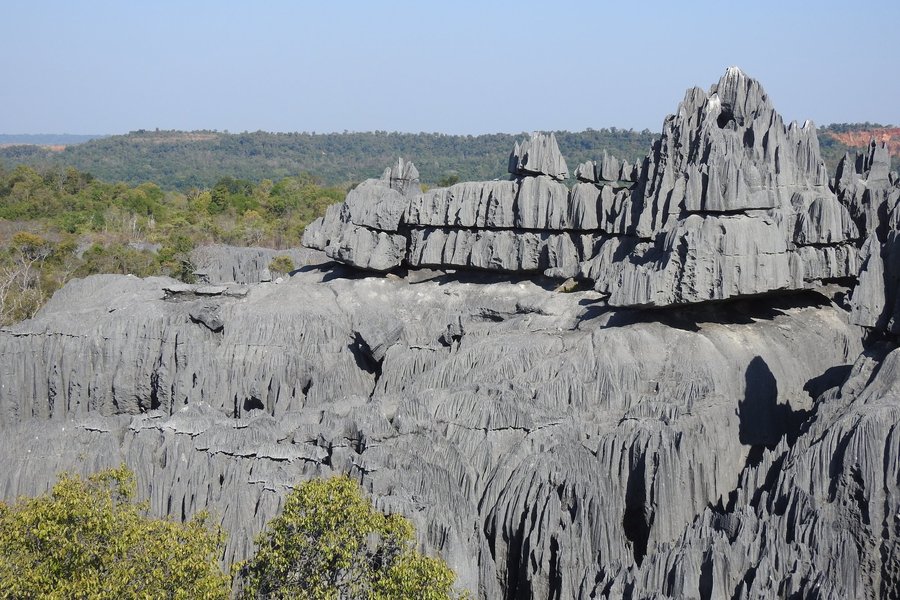
Madagascar is not quite African and not quite Asian, but rather a land unto itself. As the world’s fourth largest island, the country is generally known for its delightful lemurs and bewildering Baobab trees. And while I wanted to meet those lemurs and walk under those Baobabs, Madagascar attracted me for another reason—the Tsingy de Bemaraha.
My traveling companion, Herr Kuls, and I landed in Morondava, on the western coast, on a bright May morning. Our guide Patrick met us off the plane, and introduced himself in excellent English. Morondava is a sandy, little place. The kind of beach town that tries to put on a happy face, but is poor and indicative of the difficulties Madagascar faces. We drove directly to our hotel, kicked off our sandals and settled in. Patrick advised us to rest up for the next day. Looking out towards the beckoning beach, we told him that wouldn’t be a problem.
The stars were still twinkling when a 4x4 truck picked us up before dawn. Our driver, Monsieur Jackie, was to drive us to Madagascar’s only UNESCO World Heritage Site, the Tsingy de Bemaraha, located approximately 145 miles (235 kilometers) away. En route, Patrick informed us, we would also see the famous “Avenue du Baobab.” Tsingy itself is a collection of improbable limestone karsts, pinnacled (“tsingy”) formations. These dangerously jagged, highly eroded pinnacles form an amazing forest, unlike anything, literally, on Earth. Our journey was to see, first-hand, these distinctive formations and walk inside the extraordinary …
Keep reading 0 comments
